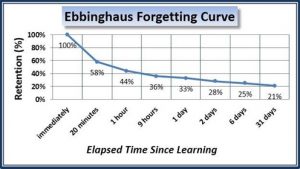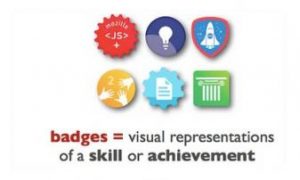How To Be Sure Your Screencast Training Sticks
Now that the new year is approaching there’s a good chance that you’ll have some New Year’s resolutions that include developing your first training video or even taking some training yourself.
A problem I see with New Year’s Resolutions that include purchasing a bunch of training courses is that so often the students receive so little follow up or ways to implement the content they have learned into action. In fact, I stumbled upon this graphic recently which shows how little we actually retain from the training we consume.

In fact, one of our members asked, in a recent Coaching Webinar, for some suggestions she could use to reinforcing the video training she was creating. She wanted to ensure that her students would be able to adopt and apply what they just learned.
Here are some ideas that Lon and I have implemented in our training and I hope to inspire you to consider applying some of these suggestions to your Camtasia and PowerPoint projects. You’ll end up with happier students who’ll continue to buying your training again and again.
Our Best Practices for Making Video Training Stick
Provide Accountability
Consider having the students actively commit to a certain goal or outcome for each Modules or at the end of your course. For example, I ran a course a year ago called the 30 Day Video Workshop where all the students had to commit to completing a short video in 30 days (in addition to some intermediate goals). Students that were able to meet their objectives were very satisfied with the course and said that they felt empowered and in integrity with themselves for having met their goals. Those were the same students that signed up when I ran the course again.
In our monthly membership we also provide accountability when students want to commit to creating parts of their video by a certain date. By seeing their deliverable we know that these students have use the training that they have purchased. These will be the students who continue purchasing our training or staying with the monthly membership as they are seeing progress on their goals.
By incorporating some sort of accountability into your video training you will end up with more motivated students and repeat consumers of your products.
Provide an Incentive for Completion
Digital Course Badges are becoming more common these days.
A digital badge is a validated indicator of accomplishment, skill, quality, or interest that can be earned in many learning environments. Open digital badging makes it easy for anyone to issue, earn, and display badges across the web—through an infrastructure that uses shared and open technical standards.

In a few of of the courses I’ve created, specifically for Virtual Assistants, they have the opportunity to earn a logo and certificate of completion that links back to the list of topics addressed in the course. This give them more credibility with clients and provides them an incentive to complete the final project.
Many learning platforms such as Teachable also provide ongoing progress bars and gaming features such as levels and rewards which keep learners engaged making it more likely that the training content will be retained.
Try adding badges, certificates, logos or rewards to people who complete your video courses and create projects based on what they’ve learned.
Include Ongoing Feedback
What if you provided a Website or Facebook forum where students could get ongoing feedback and critique on their projects? If they knew that there were other students all working to improve their skills they would likely stay motivated to continue to implement your teaching.
Lon and I do this via our Private Facebook Coaching page where we interact with our members and help provide additional resources for screencasters.
Try adding bonus Q & A webinars to allow your learners to interact with you between the video lessons. Bonus Q & A sessions will help your students deepen their understanding of the training as well as practice their new skills and share their feedback with you
Add Checklists, Worksheets and Project Plans
I have always found it valuable to be able to refer to “Cheat Sheets” and Step by Step Plans provided by a training developer to help me remember what was taught and implement the new information.
Spending a little extra time creating downloadable Worksheets, Resource Guides and other supplementary materials that your students could print out or keep handy would go a long way towards increasing the value of your course and helping students take action.
So to sum things up….
Getting adults to complete then implement the ideas in online video courses is one of the most difficult things to do. Unfortunately, there’s no single silver bullet. But there are common characteristics of good training videos that have been successful.
Think about the structure of your video course and how it either addresses or ignores these suggested practices. This will ensure that once student finished your training you will be able to sustain the excitement, see learners use the tools that are provided, implement the new information, and ultimately achieve success—which is what we all want for our training screencasts.
